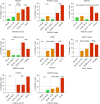Identification of Cardiac Magnetic Resonance Imaging Thresholds for Risk Stratification in Pulmonary Arterial Hypertension
- PMID: 31647310
- PMCID: PMC7049935
- DOI: 10.1164/rccm.201909-1771OC
Identification of Cardiac Magnetic Resonance Imaging Thresholds for Risk Stratification in Pulmonary Arterial Hypertension
Abstract
Rationale: Pulmonary arterial hypertension (PAH) is a life-shortening condition. The European Society of Cardiology and European Respiratory Society and the REVEAL (North American Registry to Evaluate Early and Long-Term PAH Disease Management) risk score calculator (REVEAL 2.0) identify thresholds to predict 1-year mortality.Objectives: This study evaluates whether cardiac magnetic resonance imaging (MRI) thresholds can be identified and used to aid risk stratification and facilitate decision-making.Methods: Consecutive patients with PAH (n = 438) undergoing cardiac MRI were identified from the ASPIRE (Assessing the Spectrum of Pulmonary Hypertension Identified at a Referral Center) MRI database. Thresholds were identified from a discovery cohort and evaluated in a test cohort.Measurements and Main Results: A percentage-predicted right ventricular end-systolic volume index threshold of 227% or a left ventricular end-diastolic volume index of 58 ml/m2 identified patients at low (<5%) and high (>10%) risk of 1-year mortality. These metrics respectively identified 63% and 34% of patients as low risk. Right ventricular ejection fraction >54%, 37-54%, and <37% identified 21%, 43%, and 36% of patients at low, intermediate, and high risk, respectively, of 1-year mortality. At follow-up cardiac MRI, patients who improved to or were maintained in a low-risk group had a 1-year mortality <5%. Percentage-predicted right ventricular end-systolic volume index independently predicted outcome and, when used in conjunction with the REVEAL 2.0 risk score calculator or a modified French Pulmonary Hypertension Registry approach, improved risk stratification for 1-year mortality.Conclusions: Cardiac MRI can be used to risk stratify patients with PAH using a threshold approach. Percentage-predicted right ventricular end-systolic volume index can identify a high percentage of patients at low-risk of 1-year mortality and, when used in conjunction with current risk stratification approaches, can improve risk stratification. This study supports further evaluation of cardiac MRI in risk stratification in PAH.
Keywords: disease severity; imaging; prognosis; pulmonary arterial hypertension; risk stratification.
Figures






Comment in
-
Against the Odds: Risk Stratification with Cardiac Magnetic Resonance Imaging in Pulmonary Arterial Hypertension.Am J Respir Crit Care Med. 2020 Feb 15;201(4):403-405. doi: 10.1164/rccm.201910-2069ED. Am J Respir Crit Care Med. 2020. PMID: 31726011 Free PMC article. No abstract available.
References
-
- Kiely DG, Elliot CA, Sabroe I, Condliffe R. Pulmonary hypertension: diagnosis and management. BMJ. 2013;346:f2028. - PubMed
-
- D’Alonzo GE, Barst RJ, Ayres SM, Bergofsky EH, Brundage BH, Detre KM, et al. Survival in patients with primary pulmonary hypertension: results from a national prospective registry. Ann Intern Med. 1991;115:343–349. - PubMed
-
- Ling Y, Johnson MK, Kiely DG, Condliffe R, Elliot CA, Gibbs JSR, et al. Changing demographics, epidemiology, and survival of incident pulmonary arterial hypertension: results from the pulmonary hypertension registry of the United Kingdom and Ireland. Am J Respir Crit Care Med. 2012;186:790–796. - PubMed
-
- Benza RL, Miller DP, Barst RJ, Badesch DB, Frost AE, McGoon MD. An evaluation of long-term survival from time of diagnosis in pulmonary arterial hypertension from the REVEAL registry. Chest. 2012;142:448–456. - PubMed
Publication types
MeSH terms
Grants and funding
LinkOut - more resources
Full Text Sources
Medical

